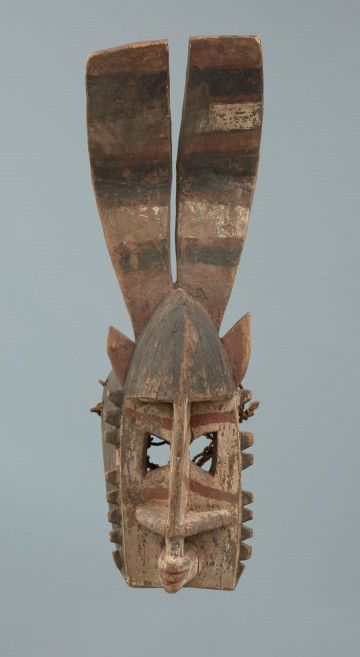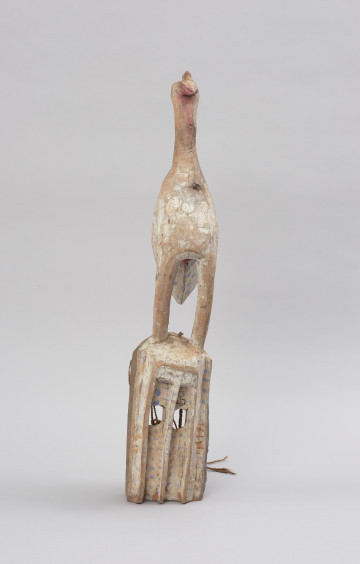
Gomintogo mask
między 1951 — 2000
National Museum in Szczecin
Part of the collection: Collection of Dogonian art
The mask was purchased in the village of Tireli directly from its wearers, who described it as the mask of a young girl from the Fula people. The Fula are a pastoralist people, neighbouring the Dogon. Conflicts often arise between representatives of these two peoples. The Dogon, who are farmers, complain about the Fula grazing their animals near their crops, while the shepherds, on the other hand, believe that the Dogon, especially those living on the Plains, are expanding their fields at the expense of their pastures. The part of the mask worn on the head, made of fibre, is finished with a hairstyle characteristic of the Fula, and the stilts, according to the Dogon, symbolise their long legs. Among the Dogon masks there are also representatives of other neighbouring peoples, such as the Bamana, Malinka and Tuareg. These peoples always have their male and female representation. It happens that similar masks on stilts are interpreted in completely different ways. Some Dogon claim that they symbolize turtledoves, while the stilts are simply a representation of trees, among which the birds live. There is also the opinion that the mask on stilts represents the Mouno deity living in the bush, very mysterious but known to have long legs.The masks on stilts never dance like the others in the circle, but they appear unexpectedly during the dances already in progress and disappear just as suddenly after a short while. They are used by members of the secret Awa society during the Dama funeral festivals.According to the Dogon, a mask is not only a part covering the face, but also a costume masking the whole figure of a dancer.
Ewa Prądzyńska
Author / creator
Dimensions
cały obiekt: height: 41 cm, width: 30 cm
Object type
sculpture, mask
Creation time / dating
Creation / finding place
Identification number
Location / status

między 1951 — 2000
National Museum in Szczecin

między 1951 — 2000
National Museum in Szczecin

między 1951 — 1998
National Museum in Szczecin
DISCOVER this TOPIC
Castle Museum in Łańcut
DISCOVER this PATH
Educational path